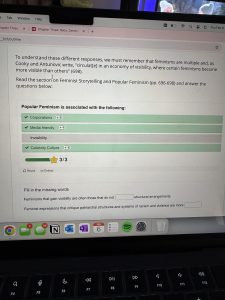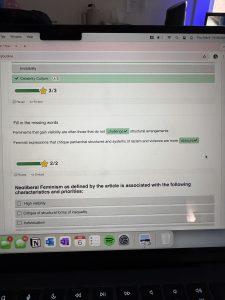3
Section One: The Fundamentals
A) Keywords
Exercise 1:
Briefly (in 100 words or less) define one of the keywords in the padlet (including one that you. may have added yourself).
| Colourblindness:
When hearing the term colourblindness most people think of not being able to see certain colours and there being an issue with your eyes leading to this. The term colourblindness when it comes to race however has a different meaning. When discussion this term when thinking about race it is often used by people to say that they do not see race and everyone is equal in their minds. They believe that this will help end racism as everyone is being seen as equal in their minds. This however, ends up contributing more to racism as they are not acknowledging the racial discrimination happening everyday within institutions and power systems. They are also down playing the negative experiences that people of colour have had to face their whole lives. |
B) Representing Race
Exercise 2: Notebook Prompt
In about 50-70 words, consider Joel Bervell’s question: why do we feel the need to extrapolate the athleticism of one Black athlete to all Black people when we do not do the same for white athletes?
Try to think of examples when this happens, making sure to reflect on your own positionality.
| The most common example of this that popped into my mind when watching the video was growing up hearing all the teachers ask my black friends if they would be trying out for the basketball team. The teachers would often to surprised when my friends said they were not going to try out and that they did not enjoy playing sports or they played a different sport. The teachers were taking this stereotype of who we believe plays basketball and placing it on my friends just because of their race. As a white presenting person I was never once asked if I would be trying out for the hockey team. It left me wondering why we place stereotypes about sports more on black people than we do white people. |
C) Gender, Race & Sport
Exercise 3: Notebook Prompt
What are some strategies for resistance that Rajack and Joseph identify in their article as a means of pushing back against and resisting misogynoir?
| Rajack and Joseph talk about the ways that Naomi Osaka pushes back against and resist the misogynoir. Naomi Osaka feels as though the media oftens likes to leave out her Haitian ancestry. She makes it a goal to talk about her Haitian ancestry during interviews as a way to remind people that just because she represents Japan in tennis doesn’t mean that her Japanese ancestry is the only important part. Another way that is stated in the article is “Osaka follows in Williams’ footsteps, flouting traditional White(’s) tennis uniforms and creating bold outfits for competition by asking African American music mogul, Pharrell Williams, to be her designer”. Which helps Naomi continue to show her ancestry well playing the game she loves. |
Section Two: Making Connections
A) Athlete Activism
Exercise 3: Padlet Prompt
Do athletes have a responsibility to use their platform for social change? Why or why not? Please remember to record your response in both the padlet below and in your Notebook.
B) Athlete Activism & Feminism
Exercise 4: Complete the activities




Exercise 5: Notebook Prompt
What do the authors of the article call for as a way of challenging how mainstream sports journalism privileges neoliberal feminist concerns? (100 words max.)
| The authors of the article say that mainstream sports journalism currently focus on neoliberal feminist concerns and they do not really look beyond these ideas. They however believe that the mainstream sports journalism needs to start going beyond and focusing on other things. They believe that they should widen their views on feminism in ways such as how the athletes use activism to engage with systems of oppression in order to start and see change. They should be looking at how sports are rooted in oppression based on gender, race, and class. |
C) Corporate social justice
Exercise 6: Padlet Poll
| In Favour:
I believe that sports leagues have the responsibility to support social justice movements such as the BLM movement. As stated in the article most of the NBA and the NFL players are black meaning the league should support the people that work for them. There is so much pressure on athletes to use their followings to talk about social justice movements yet there is no pressure out on the league to do the same thing. The leagues have big influences beyond just their players so they should be using that to show support for their athletes. When players feel supported by the league that might build a better relationship and connection between them. |
Section Three: Taking a shot
Module Assignment (submit as part of notebook and separately through Blackboard mini assignment #1 portal)
The movie that I have chosen for this assignment is Cool Runnings (1993). The movie is about the first Jamaican bobsled team to go and compete in a competition. Growing up this was one of my favorite movies yet I never fully understood the message behind it. Now looking back at the movie I can see the underlying messages that were in the movie and how they were trying to show representation for black athletes. Throughout the movie the team confronts and faces the racism that comes along with being the first team from Jamaica to compete in a winter sport. Other coaches and teams believe that the team will be no competition as none of them have done bobsledding before. When the team shows that they are real competition full of skill that is when the racism starts to heighten. Other coaches and teams now judge them based on their skin colour and where they are from. They use nasty comments and names as a way to get inside the Jamaican teams head in hopes that it will make them want to quit. The athletes did not create a big scene after hearing these racist comments throughout the olympics instead they showed everyone that being a team is more important and that the colour of your skin does not change being a team. They wanted everyone to see that the colour of your skin should not matter within sports unfortunately we can still see to this day that race plays a big part in sports. Kenneth L. Shropshire talks about it in his article entitled Can Critical Race Theory Save Pro Sports? In the article Shropshire talks about how we can still see racism in sports such as Colin Kaepernick being left go from the NFL after showing his support for the BLM movement. Kaepernick was supporting his fellow Black Americans and the consequences were losing his job showing the levels of racism still being seen in the league. Showing support and understanding that being there for each other is more important than a sport is also a key part of the movie. Although the team ends up losing the lesson that they all said they took away from the competition was learning how to be a team and always supporting each other just like Kaepernick did for his fellow Black Americans. According to Shropshire in order for there to be change in pro sports the leagues must take responsibility and make the change as they are the ones with power. For all athletes to be able to express themselves and feel comfortable within these leagues there needs to be change from the leagues and the players do not seem willing to stand down until they get this. In peaceful ways they are showing that change is more important than a sport. Bringing change for their “teams” is the most important thing such as the coach in the movie was trying to teach the boys.

